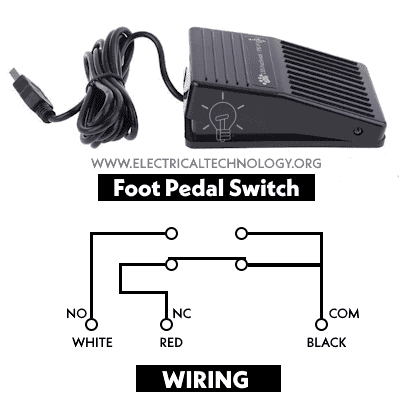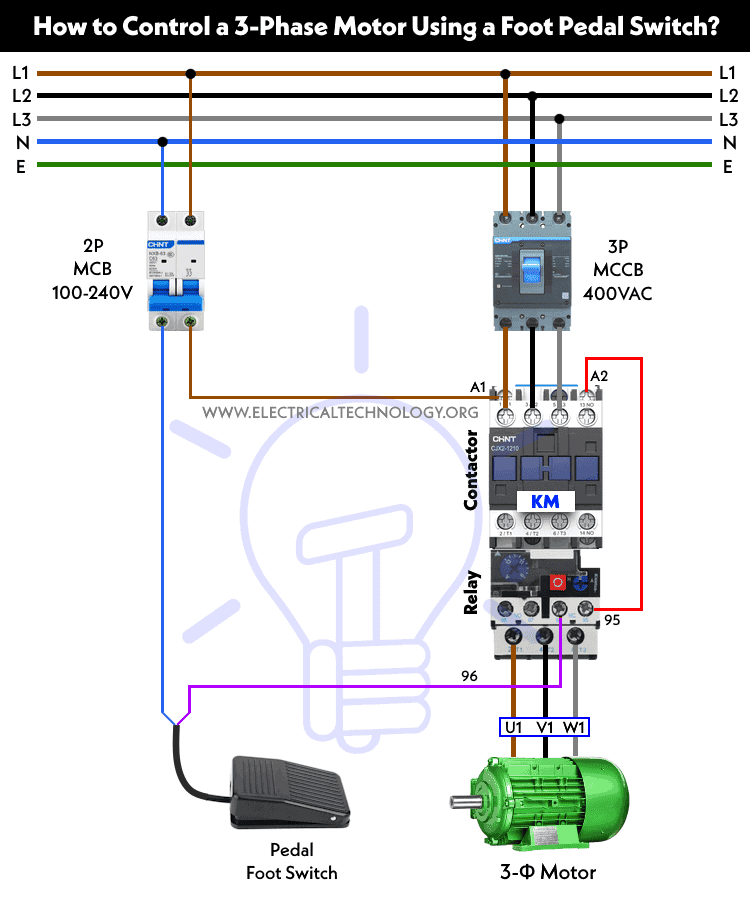How to Control a 3-Phase Motor Using a Foot Pedal Switch?
Wiring and Controlling of a 3-Phase Motor Using Momentary Foot Pedal Control Switch and DOL Starter
Controlling the operation of a three-phase motor is a common requirement in various industrial applications. While there are several methods available, using a foot pedal switch provides a convenient and hands-free way to control the motor’s start, stop, and speed. In this article, we will explore the process of controlling a three-phase motor using a foot pedal switch, including the necessary components and the wiring connections involved.
Three-Phase Motors
Before diving into the control mechanism, it’s essential to have a basic understanding of three-phase motors. These motors are commonly used in industrial machinery due to their robustness, efficiency, and ability to handle high power loads. A three-phase motor has three windings that are energized with alternating current (AC) from three separate phases of the electrical supply. By controlling the magnitude and frequency of the supplied voltage, the motor’s speed and direction can be regulated.
Pedal Switch
A foot pedal switch is a specialized type of switch that is designed to be actuated by foot pressure. It is commonly used in various industrial and commercial applications where hands-free operation is desired. The switch consists of a pedal or treadle that can be pressed down or released using the foot.
When the pedal is pressed, it completes an electrical circuit, allowing current to flow and activating the connected device such as motors. Releasing the pedal interrupts the circuit, stopping the operation of the device.
Foot pedal switches provide convenience, allowing operators to control equipment while keeping their hands free to perform other tasks. They are often used in machinery, medical equipment, musical instruments, and other applications where foot-operated control is beneficial.
Components Required
To control a three-phase motor using a foot pedal switch, you will need the following components:
- Three-Phase Motor
- Foot Pedal Switch:
- Contactor
- MCCB – 3P, 400V
- MCB – 2P, 230V
- 400V – Three Phase AC Supply
- 230V Single Phase AC Supply
- Wires, cables, switches and indicators: Manual control switches (such as start, stop, and reset buttons) and indicator pilot lights (for status indication).
Power & Wiring Connections
The control wiring connections required to control a three-phase motor using a foot pedal switch (as shown in below figure of power and control wiring circuit) are as follows:
Power Supply: Connect the three-phase power supply lines (L1, L2, L3) to the DOL motor starter’s main contactor (1L1, 3L2, 5L3).
Motor Connection: Connect the motor’s three windings (U1, V1, W1) to the output terminals (2T1, 4T2, 6T3) of the motor starter (Contactor and Relay).
Control Circuit: Connect the control circuit of the motor starter to the foot pedal switch as follow:
- Connect the Neutral wire from 2-poles CB to the Pedal Switch.
- Connect the Phase wire from 2-poles CB to the A1 terminal of contactor.
- Interconnect the A2 and 95-NC terminals on the contactor’s relay.
- Connect the 96-NC terminal from the overload relay to the pedal switch.
Foot Pedal Switch: Connect the foot pedal switch to the control circuit’s start and stop buttons. When the pedal is pressed, it completes the circuit and initiates the motor’s operation.
Speed Control: If precise speed control is desired, connect the motor controller (e.g., VFD) between the motor starter and the motor. The motor controller should be programmed to regulate the motor’s speed based on the input from the foot pedal switch.
Working & Operation
Once the wiring connections are correctly established, you can control the three-phase motor using the foot pedal switch. Here’s a step-by-step guide to operating the motor:
- Ensure that the power supply to the motor and control circuit is turned off.
- Press the foot pedal switch to ensure it is in the released (up) position.
- Turn on the power supply to the motor and control circuit.
- Step on the foot pedal switch to start the motor. The motor starter’s control circuit will close, allowing current to flow to the motor windings.
- Release the foot pedal switch to stop the motor. The control circuit will open, interrupting the current flow to the motor.
- If a motor controller (VFD) is used, the foot pedal switch can be programmed to control the motor’s speed. The motor speed can be adjusted by varying the pressure on the foot pedal.
Safety Considerations
When working with three-phase motors and electrical systems, it is crucial to prioritize safety. Here are some important safety considerations:
- Always turn off the power supply before making any wiring connections or adjustments.
- Ensure that all electrical connections are made by a qualified electrician.
- Follow local electrical codes and regulations.
- Provide appropriate protection, such as fuses or circuit breakers and use proper wire size, to prevent overcurrent and short circuits.
- Use proper personal protective equipment (PPE) when working with electrical systems.
Summary
Controlling a three-phase motor using a foot pedal switch provides a convenient and hands-free method of operation. By understanding the components involved and making the necessary wiring connections, you can effectively start, stop, and regulate the speed of the motor. Remember to prioritize safety and consult with a qualified electrician if you are unsure about any aspect of the electrical installation.
Related Posts:
- Automatic & Manual Control of 3-Phase Motor Using Delay Timer
- Auto & Manual Control of 3-Phase Water Pump Motor using Float Switch
- How to Control a 3-Phase Motor Using a Motor Protector?
- How to Control the Compressor Motor in Refrigeration Using Soft Starter?
- Auto & Manual Control of 1-Phase Water Pump Motor using Float Switch
- How to Wire ON/OFF Delay Timer for AC & DC Loads – 230V & 24V








